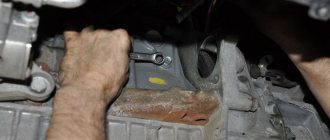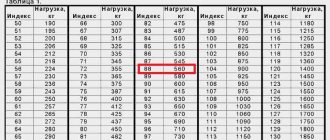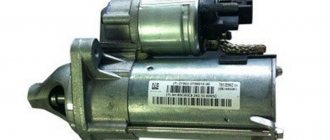The question of what Lada Largus antifreeze is poured into the system is asked by the car owner only at the moment when it is necessary to urgently add coolant to the expansion tank.
This is due to the fact that it is not recommended to mix different antifreezes with each other, as this can lead to dire consequences. Moreover, the recommendation applies not only to antifreeze of different colors, but even from different manufacturers. Most car owners are of the opinion that it is possible to mix antifreezes of the same color with each other. Alas, this is not always the case.
I'll make a small digression. Today, all antifreezes available on the market can be divided into the following classes:
- carboxylate G-12, 12+
- hybrid G-11
- Lobrid coolants G-12++ or G-13.
Do not forget also about antifreeze (or the so-called traditional antifreeze), which is well known in the Soviet Union to Lada owners.
It is allowed to mix antifreezes of the same class with each other, but it is not recommended to mix classes with each other. This can lead to unbalanced additive packages, sediment formation, or foaming of the fluid.
CoolStream NRC coolant originally from the factory
It came from the factory with yellow antifreeze.
After the start of production, the plant began to receive CoolStream NRC antifreeze, which was originally used to fill the cars.
This liquid fully complies with all the specifications and standards that apply to it. This liquid is produced by TECHNOFORM LLC . This company is a partner of both companies, and also occupies a leading position in the Russian market in the initial refueling of cars.
Currently, many well-known cars are filled with antifreeze from this company during production. Among them are Volvo, Citroen, KAMAZ, Fiat, Kia and others.
Antifreeze replacement regulations
The maintenance regulations for the Lada Largus car state that the antifreeze in the car must be changed every 75 thousand kilometers or after five years of operation of the car . Everything will depend on what comes first.
When replacing a fluid, it is important to choose it correctly, then there will be no problems with the car’s cooling system throughout its entire service life.
How much antifreeze is in the Largus cooling system?
The volume of antifreeze in the cooling system will depend on the make of the car and the type of engine. So, for example, Lada Kalina has 7.84 liters of antifreeze in the system, but Lada Largus will already have 5.45 liters.
Relay
In the same block there are relays responsible for turning on the fan. On the Lada Largus the cooling system has two fan speeds. Relay K1 is responsible for operating at maximum “propeller” speeds, and K3 for minimum speeds, see photo:
When checking the fuse, you should also inspect the relays. In this case, they must be removed from their seats and looked at from the bottom. A faulty relay will have dark marks of carbon deposits or melting. Such parts also need to be replaced.
What does the manufacturer recommend?
AvtoVAZ recommends using certain brands of antifreeze for all its cars, which should be filled when replacing the factory coolant. Among such manufacturing companies the following can be noted:
This is what is sold at most gas stations.
For the Lada Largus car, the manufacturer recommends using GLACOEL RX brand antifreeze . In this case, the brand of liquid must correspond to D-class. It is made from ethylene glycol and water.
Some car enthusiasts prefer Motul Inugel Optima Ultra . This type of antifreeze is poured from the factory for foreign-made cars.
Mixing antifreeze
It's better not to interfere. The photo shows foaming of the coolant as a result of pouring different types of antifreeze
This question worries a fairly large number of Lada car owners. It is difficult to answer this question unambiguously, since some manufacturers color their liquid in accordance with its chemical composition, while others color it at their own discretion.
Most car enthusiasts never mix coolants of different colors. Half of car owners believe that if you mix liquids of different colors, nothing bad will happen.
The operating instructions for the Lada Largus car indicate that the manufacturer may add a coloring agent to the antifreeze, which can have a certain effect on its chemical composition.
Therefore, when choosing it, you need to pay attention not to the color of the liquid, but to its composition.
FakeHeader
Comments 33
Don’t want to fill it with red? I didn't find anything negative about him. This is not my first car. Antifreeze MOBIL catalog 151154 www.drive2.ru/b/462067563623352080/
Already purchased a regular NRC, recently partially drained it to replace the thermostat. almost perfect without debris... not even cloudy.
The Nexia also had a yellow coolstream from the factory, after 16,000 km it turned into a stinking swamp, they changed it to Felix G12 red and for 3 years without changing the color it worked properly until they sold the car.
I haven’t turned into a swamp in 3.5 years and 35 thousand... I just want to comply with the regulations)
Coolstream nrs. Or any G12+.
I found the first antifreeze that came across, a poisonous yellow color, the same as it was from the factory. I recently changed the thermostat - look at the photo, original from the Vernet Calorstat factory 89 degrees. It also started to act up, I bought a replacement like the original, it looked terrible (See me about this if you are interested: www.drive2.ru/l/464746798582333899/
so you indicated that it doesn’t say how many degrees are on the thermostat... so I want to return it to 89... although they also praise someone at 89
I later found, under the rubber band, the catalog number and the response temperature. I'll take more photos in more detail.)
yes, it’s not so important to me) I ordered it will return 89 degrees... not expensive... I’ll try antifreeze at the same time too... coolstream nrs
Manufacturer's regulations
According to the regulatory requirements set out in the documentation supplied with the Lada Largus model, you can indicate when antifreeze replacement is required. The manufacturer strongly recommends changing the fluid after 75,000 miles or after five years of the station wagon being in operation. Here the owners focus on the event whose occurrence occurs earlier.
Also an important aspect is the correct choice, which will have a positive effect on the service life of most elements in the cooling system.
Rules for replacing antifreeze in Largus
The design features of the internal combustion engine are such that enormous thermal energy is released during operation, which means that it is impossible to do without a reliable cooling system. On the Lada Largus, like on any other car with a similar internal combustion engine, antifreeze is used to effectively remove excess heat, which continuously circulates in a closed circle with the ability to cool. The durability of many engine components depends on the quality of antifreeze, as well as on its timely replacement.
conclusions
You should also follow the recommendations of the car manufacturer when choosing.
In the case where the antifreeze will be sold concentrated, it must be diluted with distilled water, which should be added in certain proportions. Such proportions are usually indicated on the packaging.
Without a cooling system, normal operation of the internal combustion engine of any car, including the Lada Largus, is impossible. Heat is removed from parts exposed to temperature effects by circulating a special liquid called antifreeze. The durability of most system components directly depends on the quality of this refrigerant. Timely replacement of antifreeze is also important.
Antifreeze quality check
You should not trust the numbers on the canister; the indicated replacement period on the packaging does not always correspond to reality. Relying on these figures, it is easy to find yourself in a situation where the antifreeze, having exhausted its service life, ceases to perform its functions. And this will inevitably lead to overheating of the power plant, although replacement is not yet necessary. But you can avoid such situations and the troubles that follow.
It is recommended to learn how to independently determine the quality of antifreeze in the cooling system and, based on this check, make a decision about replacing the fluid.
There are about ten ways to determine quality, but not all of them are available to the average car owner. At home, you can check the coolant yourself using three main methods, which are the simplest and do not require financial investment.
Your actions
Knowing these simple methods, you can quickly determine the quality of the coolant at home. This way you can avoid problems with a low-quality product.
Rules for choosing coolant
The cooling system of the Lada Largus car holds 5.45 liters of antifreeze, it is recommended to purchase at least 6 liters for replacement; the remaining volume can be used for topping up during operation or if leaks occur (broken pipe, loss of radiator tightness, leakage due to weak clamps and etc.).
What volume should I fill?
The cooling circuit of the Lada Largus engine can hold 5.45 liters of liquid. This is the volume that should be purchased for replacement.
It is recommended to have a certain amount of antifreeze in reserve in case of unforeseen situations along the way (leakage from under the pipe, loss of tightness of the pump gasket, etc.).
What fluid is recommended by the manufacturer?
What antifreeze is usually poured into this model? Regarding the Lada Largus model, the developers recommend using refrigerant produced under the GLACOEL RX brand. The type of liquid itself must correspond to the so-called “D-class”. It involves the manufacture of a substance using ethylene glycol as a base, to which water (distillate) is added in a specific proportion.
The experience of the owners indicates the use of Motul Inugel Optima Ultra antifreeze as an analogue. This type of refrigerant is used by some manufacturers of foreign cars. In general, the final decision is yours, but you can rely on the experience of car owners about what kind of antifreeze is used by experienced drivers.
What if you mix it?
This question has long been heard by most car enthusiasts. Some manufacturers resort to coloring the liquids they produce based on the identity of the chemical composition, while others generally act at their own discretion.
The vast majority of owners (and not only Largus) never mix liquids of different colors. This is a very correct approach, since refrigerants with different properties can jointly harm the system.
Some owners (a minority) prove that there is no harm when mixing different colored refrigerants by resorting to independent experiments.
The manual for Lada Largus states that a special component is added to the antifreeze, which actually colors the liquid. The color of this compound depends on a specific set of chemical properties. When choosing, it is recommended to pay significant attention to the color shade of the purchased liquid, which would correspond to what is poured into the system.
Fuse
This is the first thing you should pay attention to. The protective element of the system is located under the hood, in the mounting block. Under the plastic cover there is a fuse marked F4(30A) - for cars without air conditioning and F5(40A) with air conditioning, see photo:
To check the integrity, you need to remove the element and inspect it for signs of burning. If any are found, replace the fuse with a similar one.
How to replace antifreeze?
Replacement of antifreeze is carried out when the engine has cooled down.
- We install LADA Largus over the inspection ditch.
- After waiting for the engine to cool, unscrew the cap on the expansion tank in order to relieve residual pressure in the circuit.
- Working from underneath the car, remove the crankcase protection and set it aside.
- Note that the main radiator of the system, as well as the engine block, in this model do not have special plugs that allow you to drain the waste fluid conveniently and to the maximum extent possible.
- We install a container under the radiator pipe that is capable of “accepting” at least 6 liters of old refrigerant. We take pliers and squeeze the ends of the clamp holding the hose on the lower radiator pipe.
- Move the clamp and remove the pipe. We act carefully so as not to get doused with antifreeze. At the initial stage of draining, we recommend completely closing the cap on the expansion tank. This will reduce the pressure of the antifreeze discharged into the container. As the drain progresses, the lid can be gradually opened.
- After the entire volume of refrigerant has drained, we put the hose back in its original place and secure the connection with the same clamp.
- Before the filling process, remove the cap from the fitting that is present on the refrigerant supply hose to the heater radiator.
- We pour the liquid into the cavity of the expansion tank and watch how it penetrates the system. We do this until liquid begins to flow from the open fitting, forming a solid stream. Under no circumstances should there be air bubbles, otherwise a traffic jam is guaranteed to be created, which will then reduce the entire efficiency of the system to “zero”.
- Close the fitting plug and fill the tank to the mark indicating the maximum level.
- We start the LADA Largus engine, warm it up a little, periodically raising the speed to 2500-3000 per minute. This allows any remaining air (if there is any) to be removed from the system. As the engine warms up, we turn on the heating in the cabin and notice a hot stream of air “escaping” from the deflectors.
- We turn off the unit, let it cool and inspect the system for leaks. The coolant replacement is complete.
Removing the heater system
Most Renault Logan owners are convinced that replacing the heater motor requires completely dismantling the front panel. The same position is described in the car repair and operation manual. Since such a process is quite expensive and inconvenient, many owners prefer to leave this problem unresolved. However, in reality, to dismantle the housing with the heater fan, it is enough to unscrew only a couple of screws. You can handle a similar task with your own hands.
But at the very beginning, make sure that the cabin filter is clean; sometimes, due to its contamination, air cannot get into the cabin. The filter is installed on the right side of the front panel.
If the filter is clean and its condition does not give you any doubt, you can begin dismantling the “stove”.
Tool for the job
To dismantle the heater we will need the following tools:
- Screwdriver with straight blade.
- Phillips screwdriver.
- Plastic puller (or a regular ruler).
- TORX T20 key.
Sequence of work to dismantle the stove
- Remove the door seal.
- Using a screwdriver, pry up the plastic lining of the rack and remove it from the latches.
- After this, the first screw will be visible; use TORX T20 to unscrew it.
- Then, using a flat-head screwdriver, carefully remove the plug in the lower right corner of the panel near the glove compartment and unscrew the second screw.
- Now that the panel is not fixed, pull it towards you to create a small gap.
- Then we inspect the surface behind the panel to find the fan housing. It is not difficult to find, it is round and located not far from the cabin filter.
- After the stove fan is detected, remove the chip with the power cable from it and turn the fan housing clockwise to pull it out.
There are two types of fan designs, although the differences between them are minimal.
CoolStream NRC coolant originally from the factory
It came from the factory with yellow antifreeze.
After the start of production, the plant began to receive CoolStream NRC antifreeze, which was originally used to fill the cars.
This liquid fully complies with all the specifications and standards that apply to it. This liquid is produced by TECHNOFORM LLC . This company is a partner of both companies, and also occupies a leading position in the Russian market in the initial refueling of cars.
Currently, many well-known cars are filled with antifreeze from this company during production. Among them are Volvo, Citroen, KAMAZ, Fiat, Kia and others.
Antifreeze replacement regulations
The maintenance regulations for the Lada Largus car state that the antifreeze in the car must be changed every 75 thousand kilometers or after five years of operation of the car . Everything will depend on what comes first.
When replacing a fluid, it is important to choose it correctly, then there will be no problems with the car’s cooling system throughout its entire service life.
How much antifreeze is in the Largus cooling system?
The volume of antifreeze in the cooling system will depend on the make of the car and the type of engine. So, for example, Lada Kalina has 7.84 liters of antifreeze in the system, but Lada Largus will already have 5.45 liters.
Answers (3)
From the factory, the cooling system is filled with CoolStream NRC liquid (from the Technoform company) and can be filled, changed or topped up.
You can completely change it at 90,000 km. 5.7 liters of coolant goes into the system.
antifreeze for Largus
Green will go with yellow.
Hello! It is necessary to replace the antifreeze in Largus 2012. The machine is assigned to me, and therefore I am responsible for its performance. I see that it’s written about coolstream NRS, but I don’t want to drag myself to the store, so I want to fill up the coolant from the warehouse. That's the question, the color of the coolant in the warehouse is different from what is now in the tank. Can it be filled?
No, only one color. Otherwise this could finish off your Largus
Why are you reinventing the wheel? You were told that it was filled at the factory! And in general, colors were added. The color of antifreeze does not affect anything, remember this! Just look at the car manufacturer's approval! Yes, I confirm, coolstream nrc is filled at the factory, take it. The coolant is very good, it’s not for nothing that Kamaz-master fills it for himself. I work at a dealer myself and I can say that cars with this antifreeze have no problems.
Eh, I’ll have to go to the store) Well, okay, where to go) I went for coolstream
Timing for changing antifreeze for Lada Largus
The operating rules for the Lada Largus state that the coolant in the described car is every 90 thousand kilometers . Moreover, neither the quality of roads nor the intensity of vehicle use affects this. This figure is indicated, among other things, in the car’s service book. If you purchase a new car, replacement is simple - when you reach 90, 180, 270 thousand kilometers (and so on).
What does the manufacturer recommend?
AvtoVAZ recommends using certain brands of antifreeze for all its cars, which should be filled when replacing the factory coolant. Among such manufacturing companies the following can be noted:
This is what is sold at most gas stations.
For the Lada Largus car, the manufacturer recommends using GLACOEL RX brand antifreeze . In this case, the brand of liquid must correspond to D-class. It is made from ethylene glycol and water.
Some car enthusiasts prefer Motul Inugel Optima Ultra . This type of antifreeze is poured from the factory for foreign-made cars.
Mixing antifreeze
This question worries a fairly large number of Lada car owners. It is difficult to answer this question unambiguously, since some manufacturers color their liquid in accordance with its chemical composition, while others color it at their own discretion.
Most car enthusiasts never mix coolants of different colors. Half of car owners believe that if you mix liquids of different colors, nothing bad will happen.
The operating instructions for the Lada Largus car indicate that the manufacturer may add a coloring agent to the antifreeze, which can have a certain effect on its chemical composition.
Therefore, when choosing it, you need to pay attention not to the color of the liquid, but to its composition.
Engine characteristics 21129
The engine of the Lada X-ray and other models is unpretentious to operating conditions and fuel quality. The motor has the following technical characteristics:
- Power unit brand – 21129;
- Type of power plant – injection;
- Number of working cycles – 4;
- Number of working cylinders – 4;
- The number of timing valves per cylinder is 2 exhaust and 2 intake;
- Cylinder block – cast iron;
- The piston stroke from top to bottom dead center is 75.6 millimeters;
- Working cylinder diameter – 8.2 cm;
- Power plant volume – 1596 cm3;
- Compression – 10.5;
- The maximum power of the power unit is 106 horsepower;
- Connecting rod length – 133 mm;
- The fuel used is gasoline;
- Compliance with environmental standards – Euro 5;
- The operating order of the cylinders is 1,3,4,2;
- Curb weight of the power plant – 109 kg;
- The oil volume in the crankcase of the power unit is 3.2 liters;
- Engine life 21129 – 200,000 km;
- Average gasoline consumption is 6.6 liters per 100 km.
Signs that the procedure is necessary
Antifreeze is used as a coolant in the Lada Largus car. Its main purpose is to maintain the normal temperature of the power plant due to heat removal. A malfunction of the cooling system or low-quality antifreeze can lead to the fact that internal combustion engine parts, creating enormous thermal energy through friction during operation, will not be able to cool in a timely manner. The further development of the situation is predictable.
All this leads to the most dangerous condition: engine overheating, as a result of which the internal combustion engine fails.
A major overhaul will be required, which is not inexpensive, and the process is labor-intensive. To avoid such troubles, an effective cooling system was created. One of its most important components is antifreeze. It is directly involved in heat exchange.
Reasons for using antifreeze
Many motorists, especially beginners, do not understand: why use antifreeze if ordinary water can cope with its task? It's all about the difference in chemical composition. The refrigerant is a complex chemical liquid, and this is not due to the desire of manufacturers to sell the product as expensive as possible by using more chemicals.
During engine operation, antifreeze is exposed to high temperatures, we are talking about 100 degrees or more. Any other liquid, especially water, at such temperatures begins to boil and, accordingly, evaporate. In other words, to maintain the optimal level, you will have to constantly add new fluid to the system, which is not very convenient. In addition, water contains various impurities, which, due to high temperatures, are deposited in the form of scale on the engine jacket and in the radiator, which ultimately leads to disruption of heat transfer and overheating.
Coolant replacement intervals
In modern realities, choosing an antifreeze that is ideally suited to the operating mode of a power plant is not easy due to the huge range and constantly changing technologies.
The service life, and therefore the time from one replacement to another, will be largely determined by:
- chemical composition;
- characteristics;
- the cost of a product of a particular brand.
If we refer to the manufacturers, the replacement frequency is on average once a year or depending on the mileage set by the manufacturer. For Lada Largus, the car plant's regulations provide for from 35,000 to 45,000 kilometers.
In this case, one should take into account the nature of driving, the technical condition of the engine and operating conditions. If there are negative operating factors, replacement may be carried out earlier. In this matter, you should not focus only on the mileage on the speedometer. In addition, the quality of antifreeze is also of great importance; if the cooling system is faulty, low-quality antifreeze can aggravate the situation. You cannot rely on mileage on Largus cars, which use an aluminum cooling radiator.
High-quality modern antifreeze for Lada Largus, thanks to some components in the composition, is able to retain its properties for a long time, regardless of operating conditions. For example, some brands of antifreeze, according to the manufacturer, do not need to be replaced for at least 100,000 kilometers. Such new generation products naturally cost much more, but this will determine how often the car owner will have to change the coolant. Another plus is that even a beginner can easily find the expansion tank with this liquid by opening the engine compartment. A characteristic feature is that it comes in different colors (blue, green, red).
Lada Vesta Fl 2022
By the end of 2022, the Lada Vesta Fl is expected to be released with an updated appearance. Vesta appeared in 2015, and received well-deserved success among fans. In Russia, this model ranks first in sales, which actually speaks of its popularity. The 2022 model year Lada Vesta received a new engine from the Renault-Nissan alliance with a capacity of 113 horsepower, coupled with a CVT from the manufacturer Jatco. In Russia, prices for this specification start at 799,900 rubles, this will be the Sport Start Plus package, the top-end Exclusive version is estimated at 987,900 rubles.
The updated version of Vesta, planned for release at the end of the year, will receive minor external changes, which will mainly affect the front and rear optics. The addition of FL to the name means Face Lifting, during which the model will receive updates:
- Complete redesign of optics - front and rear. We are not talking about modifying the shape of the headlight unit, but using a new filling - LED. LED sources will not only improve the appearance of a popular car, but also increase the safety of driving at night.
- Changing the shape of the front and rear bumpers.
- Increased hood relief.
- New rims.
- Modification of the trunk lid with the installation of a spoiler.
The facelift of the Vesta model, beloved in Russia, is aimed at creating a new and modern look that meets European standards.
Will there be changes in the interior of the Lada Vesta Fl
Global changes in the interior of the Lada Vesta FL model are not expected, since the main emphasis is on the exterior. Among the interior updates planned:
- change in steering wheel design with additional control buttons;
- increasing the size of the dashboard;
- updating of the front seats, which will have side holders;
- modern multimedia screen;
- increasing the center and door armrests;
- Cup holders will appear on the central panel;
- additional compartments on the backs of the front seats;
- redesign of the front console;
- a new form of deflectors, designed in an unusual style.
Budget materials that correspond to the class of the car will be used for interior decoration. Expect to see more light colors, as well as improved sound insulation.
What changes are coming in the technical stuffing
The dimensions of the facelifted Lada Vesta will not change, and moreover, the same type of engine will be used under the hood, as in previous modifications. The car will be available with two transmission options - 5-speed manual and CVT. Sales of the updated version will begin no earlier than mid-to-late 2020.
Stages of replacing coolant Lada Largus
So that the new coolant lasts a long time, and does not turn into brown sludge after a couple of months. The replacement process should consist of three stages: draining, rinsing, filling. Without a flushing step, there is a possibility that the new antifreeze will quickly lose its properties.
Lada Largus cars are equipped with 1.6 liter petrol engines:
- 8 valves - K7M (VAZ-11189);
- 16 valves - K4M (VAZ-21129).
There are slight differences between them in the cooling system. On the 8 valve there is a drain hole on the engine block, but it is located in a hard-to-reach place. For this reason, not everyone will decide to drain the cylinder block, because to do this you need to remove the starter.
Coolant drain
It is more convenient to drain old antifreeze from a technological pit or on an overpass. Therefore, we drive our Lada Largus into a garage with a pit. And while the engine is cooling, we go down to unscrew the engine protection. It is secured with 6 bolts under a 10mm head.
The preparations have been completed, now we move on to draining:
- Unscrew the cap on the expansion tank (Fig. 1).
This way, almost all the antifreeze in the cooling system is drained. Now, for the best result, let's flush the system. So that fresh coolant lasts as long as possible.
Leaks and problems
Among the known problems encountered in Largus are the failure of the thermostat and leakage of its gasket. Also, over time, you have to change the pump. Well, of course it is necessary to monitor the condition of the pipes and their connections. If cracks or severe abrasions are noticeable, it is better to replace them.
Users also note a common problem with cracks in the expansion tank, which leads to leakage of antifreeze. Quite often, cracks in the tank appear due to a jammed valve on the lid. After which it cannot release excess pressure, so it is recommended to change it periodically.











